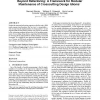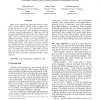308 search results - page 24 / 62 » Competing Patterns for Language Engineering |
OOPSLA
2005
Springer
14 years 1 months ago
2005
Springer
We describe (and demonstrate) the execution model of a computing platform where computation is both incremental and data-driven. We call such an approach delta-driven. The platfor...
SIGSOFT
2007
ACM
14 years 8 months ago
2007
ACM
Despite the automated refactoring support provided by today's IDEs many program transformations that are easy to conceptualize-such as improving the implementation of a desig...
WWW
2007
ACM
14 years 8 months ago
2007
ACM
Semantic similarity measures play important roles in information retrieval and Natural Language Processing. Previous work in semantic web-related applications such as community mi...
AOSD
2005
ACM
14 years 1 months ago
2005
ACM
Improving the structure of code can help developers work with a software system more efficiently and more consistently. To aid developers in re-structuring the implementation of c...
CSMR
2008
IEEE
14 years 2 months ago
2008
IEEE
Many reverse engineering approaches have been developed to analyze software systems written in different languages like C/C++ or Java. These approaches typically rely on a meta-mo...


